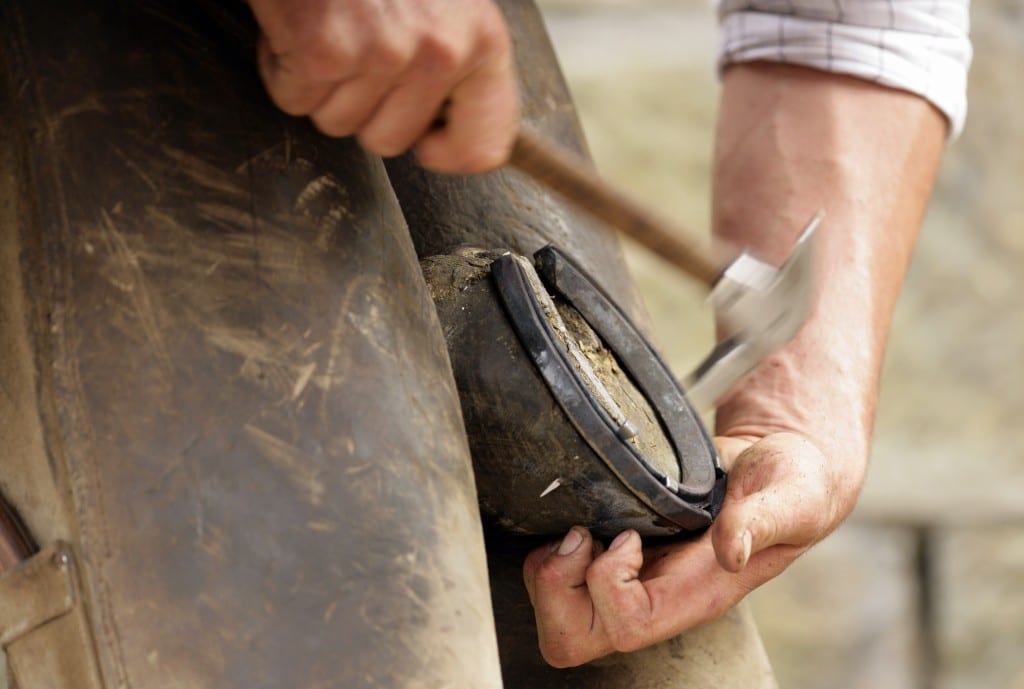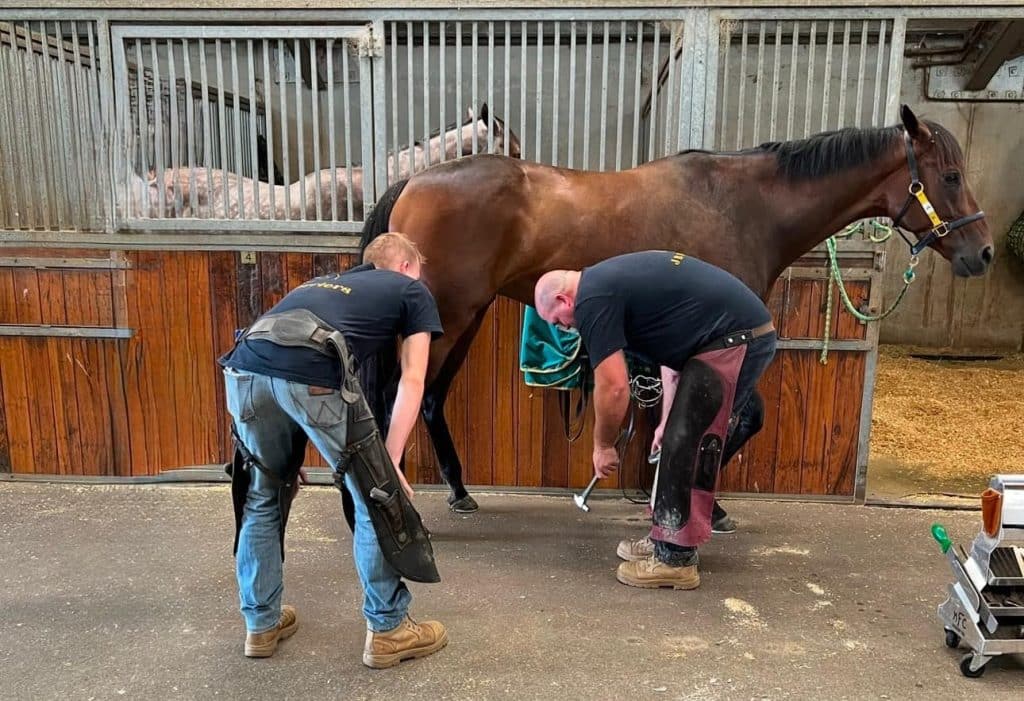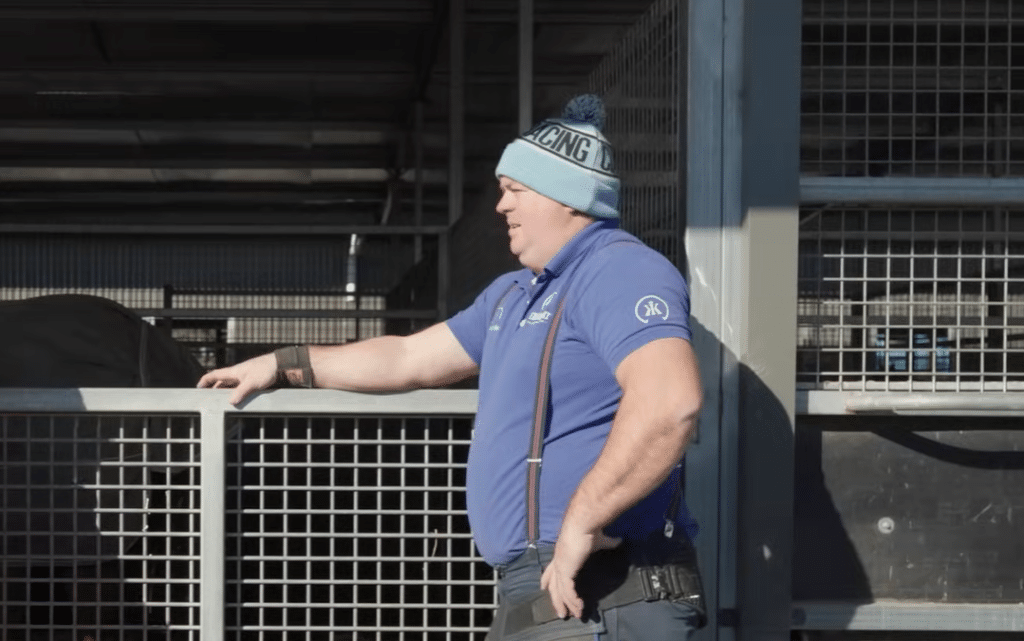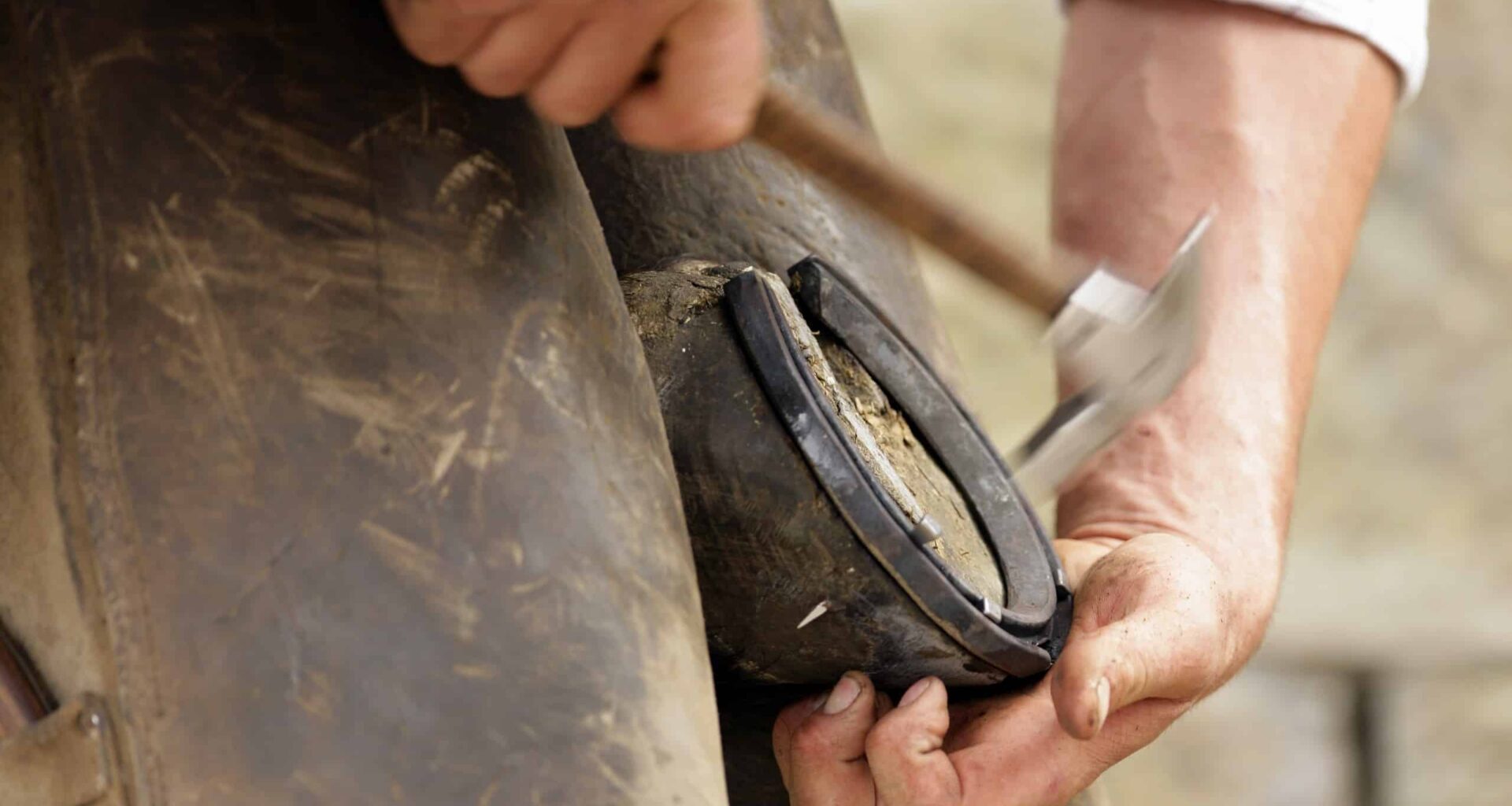 Farriers are among the unsung heroes of the racing industry, keeping the wheels turning over for the stars of the show. (Photo by Indigo/Getty Images)
Farriers are among the unsung heroes of the racing industry, keeping the wheels turning over for the stars of the show. (Photo by Indigo/Getty Images)
When the chips are down and the hooves are flying, John Bunting is most likely looking at the horses’ feet.
The farrier to the stars vividly remembers two races, both run in the spring of 2017.
Bunting’s head was in his hands when Humidor ranged up to Winx in the Cox Plate and again in the Melbourne Cup 12 days later when one of Rekindling’s racing plates went flying through the air as the field thundered for home.
Bunting, the biggest player in the farrier business anywhere in the world, says he feels no pressure tapping away under hero horses whose race-day fate rests partly in his work-hardened hands; Winx, Pride Of Jenni, Takeover Target (“terrible feet”), Gold Trip (“bad feet”) and hundreds of others.
“I dumb it down and block it out. I just look down at the toenails. If I thought too much about it I’d put myself under too much pressure,” he said. “You’ve got to see the feet, not the horse.”
Bunting has never worked behind the barriers but respects the farriers who do. The clock is always ticking, all eyes on the cobbler, sometimes with the carnival drone camera hovering overhead.
“That’s pressure, a stressful situation. I really respect those guys,” he said.
When something unexpected catches his eye, like Rekindling’s flying shoe or a rival horse getting too close to Winx, that’s when the throat tightens.
“When Humidor loomed up next to Winx, I remember thinking, ‘God, I hope she has four shoes on’. He got closer to her than any horse and I didn’t want to be the reason it happened (had she been beaten).
“I shoe a lot of the Melbourne Cup horses. You look at the stewards’ report every year. They race so tight and so muddled that horses sometimes get stood on and shoes go flying.
“But I remember Rekindling’s shoe flying off at the top of the straight and I’m like ‘you need to win now’.”
If the farrier is the race-day mechanic then Bunting is Autobarn. On average, a horse gets shod once every three weeks. A set of four shoes costs about $35 and Bunting’s team has hundreds on the books.
Bunting shoes every horse trained by leviathan Ciaron Maher, takes care of the often delicate and relatively small feet of the Werribee internationals and has been the go-to for trainers with good horses and bad feet for the past 10 to 15 years.
He is cautiously moving into the high-tech era of 3D-printed plates and shoes made from lightweight materials once used to build rockets, but now superseded.
In a game of small margins, a lightweight shoe can make all the difference. Bunting has gone around the world pursuing the best path for racing’s latest technological leap. The clop-clop of the metal is being replaced in time by a synthetic thud.
Keen eyes around the mounting yard will notice that the shine of a traditional shoe is increasingly likely to be matte.
Bunting has 15 staff and a handful of apprentices blending TAFE education in shoe-making, horse anatomy, and business studies with fieldwork.
He instils in apprentices the need to look after themselves as diligently as they do the feet of horses, at times worth millions of dollars.
 Farrier John Bunting’s services are used by many of Australia’s leading thoroughbred stable. (Photo: Supplied)
Farrier John Bunting’s services are used by many of Australia’s leading thoroughbred stable. (Photo: Supplied)
Back injury is the bane of farriers. After the spring, Bunting will undergo spinal surgery for the second time. “I tell them (apprentices) they’ve got to look after their core strength. I encourage them to do yoga and pilates,” he said.
“It’s too late for me because I’m a big unit born with an average spine but it can be very tough physically if you don’t look after yourself.”
The farrier had always been a fairly solitary figure. They’d rock up in tool-laden vans, disappear below eye level, grunt and tap and manicure as someone clutched the bridle, then shuffle along to the next client.
Bunting learned at Newmarket in the UK, world racing’s training epicentre, that shoeing could be big business.
He grew up around Epsom and Bangholme, southwest of Melbourne. His parents were members of the Hunt Club. He rode ponies and followed a cousin into shoeing, working for a range of big yards in Melbourne and Sydney after an apprenticeship around Cranbourne, which was more a training village than the horse metropolis it has become.
He travelled.
“I was at Newmarket in 2004 and worked in a (shoeing) business that had 12 guys on the books. That was unheard-of when I left Oz,” he said.
“To me it made sense. We race every day bar Christmas day. It’s a 365-day a year job and it made sense to create a team, structure it in a way where people were well organised and allowed a day off.”
Bunting has become a relatively small but important industry employer. His handful of apprentices are at various stages of their four-year journey. The operation covers Pakenham, Cranbourne, Flemington and Ballarat – meaning most of the state’s horses.
Bunting and his sub-contractors shod the Godolphin horses in Melbourne and Sydney and when Agnes Banks closed, they then moved across to Randwick where they work with Michael Freedman and Anthony and Sam Freedman. As an apprentice, Bunting shod the Freedman horses back in the St Ives era at Moorooduc.
 John Bunting has travelled the world to master the art of looking after horses’ feet. (Photo: Screenshot)
John Bunting has travelled the world to master the art of looking after horses’ feet. (Photo: Screenshot)
There is special intimacy in the relationship between horse and farrier, and farrier and trainer.
There is danger, but mostly something innate in the way horses respond to feet care. Bunting has been “badly” kicked just three times in 20 years and says “they are an animal programmed to take fright. You’re a better chance of getting kicked sneaking up on it than working underneath it.”
There is a Humpty Dumpty element to horses and the role played by their cobblers.
Many horses, including greats Takeover Target and Gold Trip, had to be put back together. It started with the feet – and all feet are different.
The Europeans who now flood our horse ranks have smaller, finer feet. Old-style Australian horses had dinner plates.
“The traditional Aussie horses probably had size seven feet, the imports somewhere between a five and a six. That’s fine, you just adapt,” Bunting said.
In mechanical terms, Takeover Target and Gold Trip had wonky wheels.
“Takeover Target didn’t have good feet. He had a particularly long toe and a special shoe. I only shod him once or twice but he was a remarkable horse given his feet,” he said.
Gold Trip almost pulled off the Holy Grail in 2022. He’d run second in the Caulfield Cup then won the Melbourne Cup after a luckless ninth in the Cox Plate.
“He was a favourite of mine because he won the ultimate prize didn’t he? Everyone put so much effort into him. It was hard work getting him there, the beach, managing him,” Bunting said.
“He’d had 12 months out (with injury) and in that time developed laminitis. There was the re-growing of the hoof and the rehab, his front feet especially. He nearly won the Cups double.
“It’s funny. There is so much stigma about glue-on shoes – you know, they can’t win – but Gold Trip nearly won the Cups double with glue-ons.”

There was great satisfaction in the battle won to keep Our Ivanhowe and Lucas Cranach on track for Cups bids.
Our Ivanhowe was a monster-sized import who ran third in the 2015 Caulfield Cup and arguably should have won. Lucas Cranach was another import who ran fifth in the 2011 Caulfield Cup and third in the Melbourne Cup the same preparation.
One of the stories of that spring was Freedman’s battle to keep Lucas Cranach sound. All cameras were on Freedman and the horse, few on the farrier.
“He cracked a foot in the paddock just before the Caulfield Cup and it was a battle for everyone to get him back on track,” Bunting said of Lucas Cranach.
“Our Ivanhowe was a big, strong German stallion who had the most horrific feet. I worked together with another farrier, Michael Chase. It was a special effort all-round.”
Bunting has spent most of his professional life looking down at the feet rather than up, straining that spine, but he does take it all in.
“I love the game, that’s the main thing,” he said.
“These great horses I tend to have taken me all over the world. Lovely, lovely horses. They’re like people. Different personalities, different feet.
“There is pressure because there is so much at stake but only what you make of it. There’s an old Irish fella at the (Werribee) quarantine centre who summed it up. He said pressure is for car tyres.”
